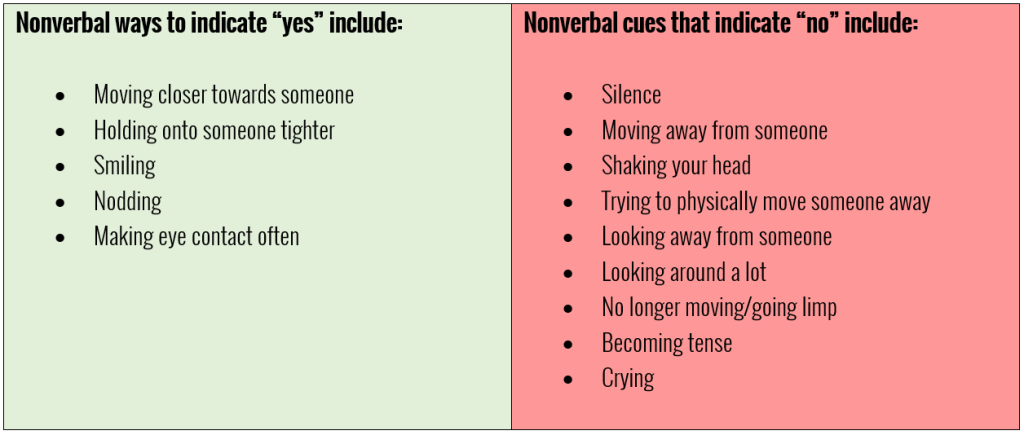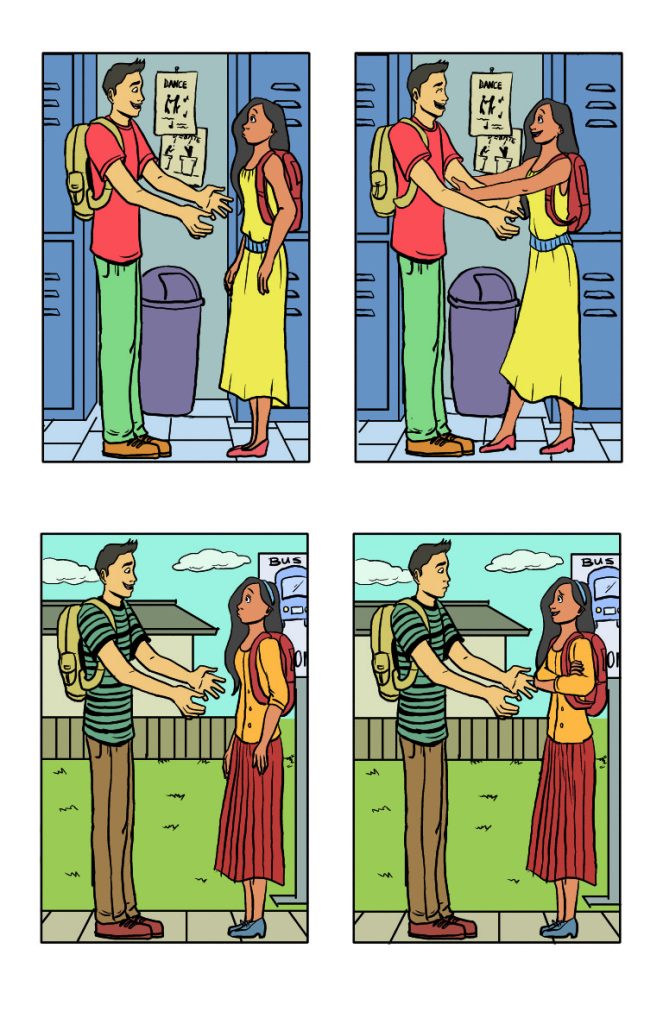Under what circumstances is it appropriate to ask for consent?
Asking for consent is usually part of a larger relationship – it’s not the very first step. Before asking for consent, it helps to know the answers to the following questions:
- What type of relationship do I have with this person?
- What types of behaviors are appropriate in that kind of relationship?
- Does it seem like this person is interested in what I want to ask for?
In the Healthy Relationships section of this guide, we explain that sexual and romantic consent is limited to certain types of relationships. Teachers, bosses, helpers, and family members should never engage in sexual or romantic behavior with you. For the same reason, they should never ask you for sexual or romantic consent. By the same token, you should not ask them for their consent.
Asking for consent looks different, depending on the type of relationship you have with someone. For example, if you are close friends with someone, you may be comfortable hugging and have hugged many times before, even though you would still ask, “Can I give you a hug?” On the other hand, if you think an acquaintance is attractive but you have not spoken much to them, hugging would not usually be expected. If you asked that person the same “can I give you a hug?” question, they might become uncomfortable or avoid you in the future.
That does not mean you can never become closer to someone you do not know, but building that relationship takes time. Most people try to figure out if their interest in someone else is mutual before ever asking to touch them. If you are romantically or sexually interested in someone, that mutual interest is often established by flirting – see the section of this guide on Flirting for more information.
Consent With Strangers
In general, it’s not appropriate to touch strangers. However, sometimes you might need to get someone’s attention. If possible, it’s best to get people’s attention either verbally or without touching them (by waving, for example). If that does not work, it’s usually alright to tap someone lightly on the forearm or shoulder once or twice.
Socially Inappropriate Actions
Some actions are not socially acceptable, so it wouldn’t be appropriate to ask consent to do them. Usually these are actions that make people uncomfortable. Following people as they move from place to place, staring at them, or making gestures about their body would all be considered inappropriate. You would not ask someone for consent to do these behaviors.
For example: Ryan sees Yvonne at the coffee shop – he’s had a crush on her all year at school. He realizes that he is staring at her as she orders her coffee. Ryan knows it is impolite to stare, so he quickly looks back to the book he was reading before Yvonne walked in. Even though he really wants to look at Yvonne, he doesn’t ask her for consent to stare at her, because staring isn’t socially acceptable and can make people uncomfortable. Ryan decides that a better way to show his interest would be to ask Yvonne when he sees her the next day at school if she would like to go on a coffee date.
Additionally, whether various actions are inappropriate depends on the relationship you have with someone. Asking someone for a hug, to kiss them, or have sex with them would all be dependent on the type and duration of the relationship you have with the person.
For example: CJ met Ross at a recent event. They seemed to be flirting with each other, and they decided to meet up at a coffee shop. At the end of the coffee date, CJ really wanted to kiss Ross, but since they were just starting to get to know each other, CJ knew that kissing might not be appropriate. Instead, CJ asked, “May I hug you?” Ross opened his arms wide and smiled, indicating that a hug was consensual.






